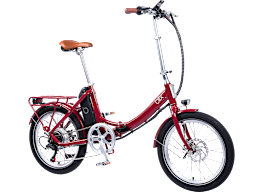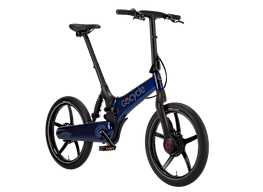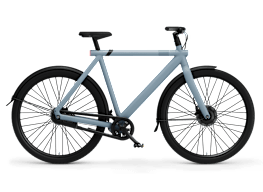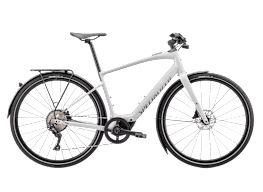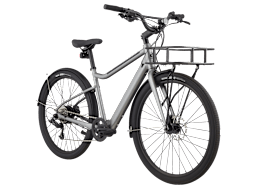How to Choose an Electric Mountain Bike
CR's experts share key insights to help you find the right e-bike for your needs and budget
When you shop through retailer links on our site, we may earn affiliate commissions. 100% of the fees we collect are used to support our nonprofit mission. Learn more.
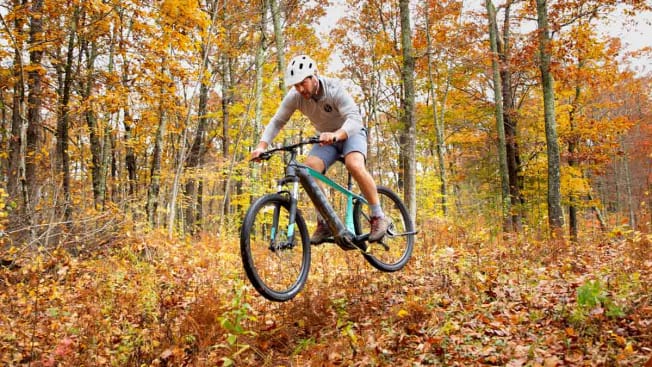
Electric bikes have become wildly popular over the past few years. Equipped with electric motors that give the rider varying levels of assistance, they can make it possible to ride farther and climb hills without getting as tired. The extra boost can also allow someone to cover more distance than a conventional pedal-powered bicycle would allow. E-bikes’ hill-climbing prowess has led to an inevitable spread into types of enthusiast-focused bicycles whose riders often pride themselves on using leg power alone: namely, mountain bikes.
Consumer Reports tested nine electric mountain bikes from Giant, Schwinn, Specialized, Trek, and other brands. Just as their price varied, so did their performance on woodland terrain. Some did better on the tricky types of terrain you would encounter on many recreational mountain bike trails, and most were fun to ride on unpaved roads.
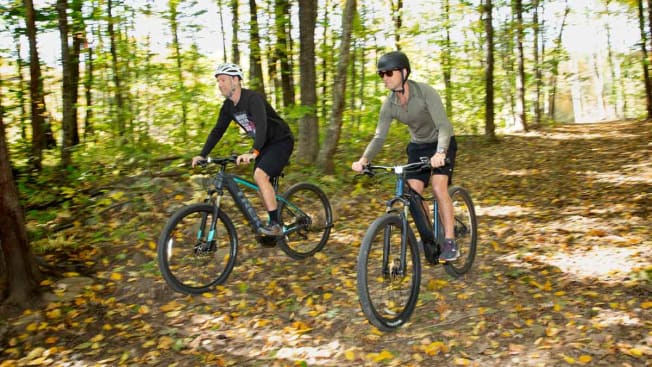
Photo: John Powers/Consumer Reports Photo: John Powers/Consumer Reports
Can I Ride an E-Bike on the Trails Where I Live?
Always check local laws and ordinances before taking an electric bike on any trail, or even on public roads. Some state and municipal governments consider them more akin to motorcycles. Consequently, they won’t allow them on trails and pathways where conventional cyclists and pedestrians might be present. Keep in mind that trails are usually subject to the rules of the landowner, whether that’s the government, an association, or even a private individual.
“It’s important to get a bike you can actually use,” says David Wiens, executive director of the International Mountain Bicycling Association. “If it’s not allowed on the trails where you want to ride and you can’t ride it, what’s the point?”
Why an E-Mountain Bike?
Naturally, there are two sides to every story. Wiens says that reception of e-mountain bikes within the mountain biking community has been mixed, but he points out that regardless, their numbers are noticeably on the rise. To some enthusiasts, adding electric power to the type of bike that was designed to help the rider get away from it all defeats one of the main purposes of a mountain bike. After all, why add complexity and weight to something that could—if it broke—leave you stranded? And if fitness is the goal, why diminish your leg workout with an electric motor?
Others are convinced that an electric motor is just what they need to be able to keep up with mountain bikers who are more skilled, or who are better able physically to handle the grueling work of pedaling up and down steep, loose terrain. After all, legging it up a rocky incline can leave even the most fit person huffing and puffing within a few minutes. So there is a case to be made that some people who are older or heavier, or who suffer from various limitations that might otherwise prevent them enjoying conventional mountain biking, could still participate in the sport with a little boost from an electric motor. Then there’s the fact that an e-bike allows the rider to go farther than they could on a pedal-powered bike.
“I bought an e-mountain bike because I’m 200 pounds, and it’s quite hilly where I live,” says Ace Bollinger, a member of the e-bike committee within the Evergreen Mountain Bike Alliance, a nonprofit based in Washington state. “There are a lot of great athletes on the trails out here, and I’d always be the guy at the back of the pack. I thought, ‘I can’t do this, or I’m going to hurt myself.’”
The e-bike allowed him to keep up and provided the motivation (literally and figuratively) he needed to ride his bike more often.
“To me, more miles means more smiles,” he says. “[Consequently] I’m more fit, and I’ve been losing weight.”
There is merit to both ways of looking at e-mountain bikes, and while riding various models in the woods on both unpaved roads and single-track trails recently, CR’s testers found that people who are new to mountain biking should take extra care because of the added, and sometimes surprising, power of the electric motor.
“If you can’t keep up with a seasoned mountain biker on a conventional, pedal-powered mountain bike, what you probably need—more than an electric motor to help you pedal up hills—is better bike-handling skills,” says Jake Fisher, senior director of CR’s Auto Test Center. “Single-track mountain bike trails can be highly technical, so that extra help from an electric motor could actually push you right past your ability to negotiate obstacles without falling over.”
As an example of this phenomenon, your humble chronicler of these tests rode an e-mountain bike on an uphill section, and although impressed at how fast and easy it was to pedal up a steep hill, ended up overshooting several critical terrain features and having to stop in the middle of a steep slope—making it difficult to recover forward momentum.
Anyone who has been mountain biking knows that when the trails get too rough, some riders will need to walk or carry their bike over some obstacles, such as large boulders and downed trees. Less experienced riders will need to do this more often, regardless of whether they’re riding an e-bike or a conventional one. We found that carrying the heavy e-bikes could be extremely difficult.
Consensus among testers was that electric mountain bikes, although novel, might not be the best option for someone who’s serious about mountain biking, and for a variety of reasons. The models CR tested were, however, ideal for riding on dirt or gravel roads—provided they weren’t steep enough to overcome braking power or the ability of the electric motor to assist hill climbing. That could be good news for a commuter who lives in a rural area where paved roads aren’t a given.
As with SUVs and pickup trucks kitted out with big off-road tires, brush guards, and other outdoorsy-looking gear, e-mountain bikes have a certain aesthetic that people might enjoy, regardless of whether they plan to actually use the capability.
Since most e-bikes are powered by lithium-ion batteries, it’s a good idea to familiarize yourself with the potential safety risks associated with that type of battery, and the proper care techniques that can help minimize those risks. For starters, fire officials recommend using only manufacturer-approved chargers and batteries with your electric bike.

Photo: John Powers/Consumer Reports Photo: John Powers/Consumer Reports
How Heavy Is an E-Mountain Bike?
Most of the models CR tested were in the 50-pound-plus range, which is heavy when you think about having to lift one onto a bike rack or into the back of a pickup truck. Trying to wrangle one onto a roof rack seems a bad idea for a variety of reasons, not least of which is safety. For CR’s testers, safely loading the heavy e-bikes into a pickup truck was a two-person job, which might not be great for someone who just wants to grab a bike and go for a ride somewhere after work or school. (See our picks for the best bike racks.)
Another downside of the weight of the bikes we tested was braking performance. A steep downhill can put a lot of pressure on a mountain bike’s brakes, and testers could smell the brakes heating up on a couple of the less expensive models as they were pushed beyond their capacity. Anyone who has ever experienced brake fade in a car—when the brakes get too hot and can no longer slow the car—knows that this would be a terrifying scenario to face while coasting a bicycle down the side of a mountain.
Yet another potential downside of the added weight is the challenge in pushing or carrying it back to the trailhead. Someone who rides an e-mountain bike deep into a wilderness area should consider what they would do if the battery ran out of charge, or the bike got an irrepairable tire or other damage midride. It’s one thing to have to roll or carry a 25- to 30-pound conventional mountain bike out of the woods or desert, but a stricken 50-pound mountain bike would be seriously challenging to transport. The complexity added to an otherwise simple machine creates new failure points that could—if something goes wrong—leave you stuck. It’s worth considering that you may be able to ride farther on an e-bike than on a conventional one, so running out of battery charge or suffering mechanical failure during a long ride could leave you much farther from help.
Should I Get Mid-Drive or Hub-Drive?
If you’re really keen on using an e-bike on mountain biking trails, your best bet is probably a mid-drive model, in which the electric motor sits where the pedal crankshaft normally is on a conventional bike. This setup allows the electric motor to send power through the gears, giving the rider the option to select the gear that will pair the electric motor with the most efficient mechanical advantage for driving the rear wheel.
Mid-drive models’ motor sensors are usually torque-based, which gives more immediate feedback to the rider’s pedal input. For both of these reasons, mid-drive bikes took less leg power to get up steep hills in CR’s testing.
The entry-level models CR tested had hub-drive motors. They live in the hub of the rear wheel and send electric power directly to the rear wheel without running it through the gears. This means that although the motor worked well on flat ground, it offered limited assistance on steep hills. Also, these models had a cadence-based sensor, which measured the speed of the rider’s pedal revolutions and applied electric assist accordingly.
Inherent in the hub-drive setup was a bit of a lag from the motor—it didn’t kick in immediately, and continued applying power after pedaling had stopped. Although the lag was only a split-second on either side, it was enough to create some unease on mountain bike trails, where a split second can mean the difference between making a sharp turn and going off the side of an embankment.
All told, the hub-drive models were plenty of fun to ride on dirt roads and still offered the fatigue-saving assistance someone might want from any e-bike on paved surfaces.
Which Class Should I Get?
There are three e-bike classes, and each one has its advantages and disadvantages. Consumer Reports does not test Class 3 bikes, which include more electric assist than the other two classes.
Class 1 includes pedal-assist bikes, which power the electric motor as your feet apply pressure to the pedals. There’s no throttle control on the handlebar to get the bike going; the electric part works only when the rider is pedaling, and the e-assist cuts off at speeds above 20 mph.
Class 2 bikes also have an electric motor that works up to 20 mph, either while the rider is pedaling (pedal-assist) or with electric propulsion alone, via a throttle control.
Class 3 provides electric assist up to 28 mph. These faster, more powerful models might not be legal to ride in some areas, such as on bike paths.
Who Has the Right of Way?
There’s a reason e-bikes still aren’t allowed on some trails: As motorized vehicles, they’re seen by many people as cousins of dirt bikes. Wiens says public perception of e-mountain bikes in areas that limit their use tends more in this direction. But he also says that a little goodwill can go a long way where e-mountain bikes—any mountain bikes, really—are concerned.
“If you’re going to go e-mountain biking, you’re a mountain biker, so you should really have a foundational knowledge of best practices,” he says. “There are going to be hikers and runners and other users on a lot of trails, and typically, bikers—whether on an e-bike or an analog one—are the fastest users on the trail, so they have to be aware of that and act accordingly.”
Test Results
Below are some of the models CR tested, revealing our picks for best overall, best for trails, and best entry-level bike. These are presented with their Overall Score, which incorporates our test results for range, ease of use on the trail, and braking, among other parameters. Each of these electric mountain bikes has particular strengths and weaknesses, and some are much better on technical trails than others. But they were all pretty decent on unpaved roads, provided they weren’t too steep.
If you’re a Consumer Reports member, the highlights of our expert reviews and ratings are available to you. If you haven’t signed up yet, click below and become a member to access this full article. Joining also gives you full access to exclusive ratings for the other products our experts evaluate in several categories, including electronics and home appliances.
















